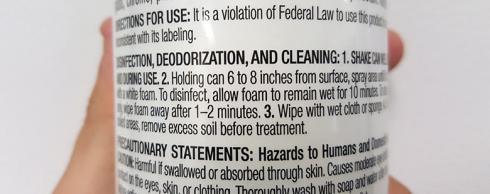
Corners you shouldn’t cut when cleaning your floors
1) Skipping pre-sweeping
If you have a disc floor scrubber, you should be pre-sweeping. Your scrubber is putting down water to clean. Dirt plus water equals mud. Therefore, removing excess dirt prior to scrubbing will help your scrubber clean more thoroughly. Pre-sweeping also removes residues that put added stress on your machine’s vacuum system. If you are using a cylindrical scrubber or a scrubber-sweeper, pre-sweeping is not necessary but still couldn’t hurt.
2) Not using the right chemical/dilution ratio
Choosing the right chemical is important for the health of your machine and for the effectiveness of your cleaning program. Some chemicals can damage the machine or create excessive foam. Avoidable damage such as this can void your warranty. One added benefit of opting to purchase your equipment, parts or chemical from a reputable equipment distributor is access to their industry knowledge about key things like which chemical is best for the machine, surface, and application.
Take your time when measuring your chemical to ensure proper dilution ratio. If there is too much chemical, the floors can become either slippery or sticky from the excess chemical. If you use too little, your floors might not get as clean as they should. None of these outcomes are ideal. Using the right dilution ratio will also help you reduce chemical waste. Some concentrated chemicals come already pre-measured for you. This helps you “cut corners” without making a costly mistake. Clean & Green, for example, is a concentrated, environmentally-friendly, neutral detergent that comes in pre-measured 2oz, 5oz and 15oz packets.
3) Ignoring dwell times
The dwell time, or contact time, is the amount of time a disinfectant sits wet on a surface. Allowing for the indicated dwell time is a crucial step in disinfecting floor surfaces. If the dwell time on the product’s label is not followed, germs and pathogens can survive the application. If you’re not sure of the difference between cleaning and disinfecting your floors, check out our guide to cleaning vs disinfecting vs sanitizing.
If you are simply cleaning your floors with detergent, you do not have to worry about dwell times. For surfaces that require disinfecting, like gym mats, you should always follow the labelled dwell time. Remember that the disinfectant must remain wet while it sits on the surface, and how quickly a disinfectant dries varies based on a number of factors. Dwell times for a disinfectant vary from product to product and usually range anywhere from two minutes to ten minutes.
4) Scrubbing as fast as you can
As the saying goes, “a job worth doing, is worth doing well.” Whether using a walk behind or rider scrubber, going at a slower pace allows the brushes and chemical more time to lift stubborn residues from floors. Scrub slowly in straight, parallel lines with a slight overlap. Even at a slower pace, you will still be cleaning at a much faster rate than traditional floor cleaning methods. Take your time with the machine to do the job right.
5) Not cleaning your machine
Every scrubber operator should be cleaning out the recovery and solution tanks after every use. The solution tank on an industrial grade floor scrubber can hold chemicals strong enough to strip the finish off of floors. Leaving solution in the solution tank overtime can clog filters and slow productivity. A floor scrubber eats dirt, oils, grease, odor causing bacteria and other particles that you don’t want lying around on your floors. All of this is stored in its recovery tank. Let that mixture of filth sit in a tank without cleaning it and, not only will it smell terrible, but the grime will turn into a sludge that is now difficult- and gross- to clean. Cleaning your machine after every use helps prevent clogs and overheating. Chemical buildup in tanks that aren’t cleaned regularly can also contribute to excessive foam.
Since caring for tanks is so important, your machine’s tanks should be easy to access and clean. Clear hoses and lids are great features to look for in a floors scrubber since they allow the operator to see if there is a clog, if the tanks are full or if there is excessive foam in the tank. If the water tanks overflow or if there is too much foam, the vacuum motor on the machine can be damaged.
Industrial grade equipment is designed to clean up some really nasty stuff. It all goes into the machine. The machine needs to be cleaned in order to continue to operate at peak productivity.
6) Not Rotating Your Brushes
We recommend rotating your scrubber brushes every week or two. This will extend the life of the brushes and help keep your machine performing at its best. After about 20 hours or so of scrubbing, the bristles on the brushes will begin to bend in the direction the brush is turning. To help keep the bristles straight and the brush working well, simply rotate the brush so the brush is rotating in the opposite direction. (If you have a single brush machine, this doesn’t pertain to you.)
7) Not Caring for Your Batteries
The batteries found on most battery operated floor cleaning equipment require some maintenance in the form of adding distilled water periodically. With new batteries, you’ll want to check the water level every few weeks to determine how frequently you’ll need to add water to your batteries. Keep in mind that this amount of time will likely shorten as the batteries age. There is an option for maintenance free batteries, but these batteries (AGM) are more costly, have a shorter run time and a shorter life expectancy.
Once a flooded battery runs dry, the battery life will lessen and will never be as good as it once was. Poor battery life is one of our most common and most expensive complaints, and it is often due to operators neglecting their battery maintenance. Replacing a battery can run upwards of $1000.
One of Tennant’s latest innovations allows you to mostly forget about your batteries while still having them cared for. The Tennant T500 includes an option for Tennant’s Smart-Fill battery watering system, a system that automatically waters your batteries from a distilled water reservoir on the machine, and IRIS, an alert system that sends email alerts letting you know if the reservoir needs to be refilled as well as other diagnostics. You don’t want to cut corners when it comes to caring for your batteries, but if forgetting about your battery maintenance sounds appealing, you may want to consider adding the Tennant T500 with IRISto your cleaning fleet.
Saving time and money is what utilizing quality, industrial, floor cleaning equipment is all about. Even though some shortcuts may save a little bit of time in the short term, in the long run they end up costing more: more time wasted fixing a broken machine, productivity lost due to the machine not working as well as it should, and money wasted replacing parts before you should have to. Make sure your equipment operators know that you value preventive maintenance by giving them the time they need to do the job and care for the machine the right way. There are times when cutting a corner is a smart choice but, more often than not, when it comes to your floor cleaning equipment, cutting corners will cost you.
Source: thesweeper

